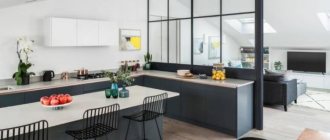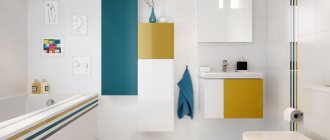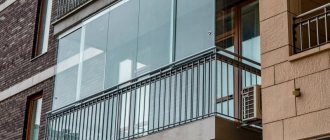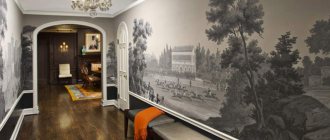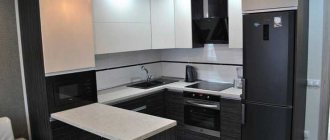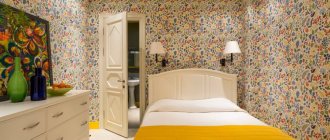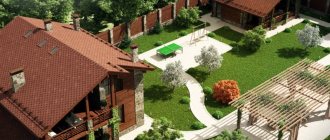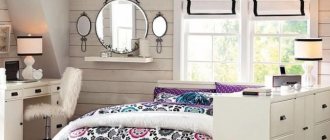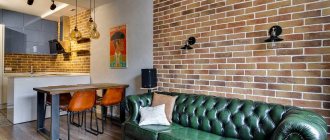Studio apartments, large premises, country houses, as well as small living spaces need comfortable furnishings. Choosing a partition for zoning space in a room of any type is the best way to divide the room into several functional areas. And you can use at least 10 materials and types of structures for this.
Interior fences differ from each other in shape, method of implementation, mobility and functionality. They can be decorative and discreet, stationary and transformable. The choice of design is influenced by the characteristics of the room and the tasks that the partition must perform: visual separation, complete sound insulation, temporary separation of space.
But they are united by advantages:
- choice of materials - glass, plastic, wood, plasterboard, metal - there is a product for everyone “to their liking”;
- durability;
- environmental Safety;
- adaptability to the design message;
- aesthetic appeal, neatness.
The disadvantage of decorative fences is low sound insulation. Some options are expensive.
Types of partitions
When choosing partitions for zoning space in a room, several parameters are taken into account: the size of the room, its type (living room, bedroom), and interior concept. When decorating a room, take into account what technical characteristics the partition should have. Do you need good sound insulation, how practical will a homemade wall be?
If only visual separation is required, then choosing heavy stationary materials for zoning is not an option. If there is a lot of space, the technical parameters of the room allow it, and the owner wants to get 2 full rooms from one, then the brick form of the structure is the best choice.
Choice for the living room
A place where people spend a lot of time is often combined with other functions. There are many ideas for partitions for zoning a living room: decorative, stationary, sliding and even hanging. The type of structure for dividing the space of the room is chosen by all family members.
When choosing the color and material of the future product, the furniture set, as well as the space division area, are taken into account. For example, when separating the kitchen from the living room, it is better not to use wrought-iron partitions, as they get very hot.
Combine several types of designs in the living room. Separate the kitchen with a glass or plasterboard partition, and to temporarily isolate any area, use modular elements - screens.
The living room uses shelves filled with books, decorative items, and plants. This is the most practical of the original methods. Tall structures fill the living room with endless comfort and zone the room well. But the racks can also be low - 1-1.5 meters.
Other solutions are also successful in the living room: bar counters, aquariums, hedges. The last option is most interesting when separating the front part of the room, in which there is a large window (or several).
Bedroom
In small apartments, decorative partitions for zoning the bedroom are used:
- when separating the work area from the rest area;
- to separate the bathroom;
- when arranging a dressing room or changing area.
Here you can install a glass structure, a carved partition, a screen, or choose a sliding compartment for cozy and functional zoning of space.
If the bedroom is combined with an office, it is necessary to zone the rest area: it is psychologically difficult to work in the same room where a person should sleep.
Even a small screen that takes up minimal space will have a good effect on your well-being and will perform its function 100%.
Kitchen
If a boundary wall is needed in the kitchen, then it is usually used to separate the dining room and the food preparation area. Here you should choose practical products that are not afraid of moisture: glass, plasterboard treated with a special coating, thin plastic, or well-protected wood. If the separating part is installed far from the stove and sink, then you can be more daring in your choice of materials.
An interesting solution is a false partition made of a wooden frame with tightly wound wire. It does not heat up as much as forged metal, allows air to pass through, but prevents strong penetration of odors. The cost of the structure, in contrast to a forged partition, is several times lower.
Children's room
There are 3 zones in the child’s room: rest, study, playground. By zoning large rooms, conditions are created for the baby to sleep and play; from a psychological point of view, it becomes easier for him to switch from one type of activity to another.
A practical way to divide the space in such a room is to use shelving with inserted boxes. If the space does not allow, then you can make a sliding structure or create a thin partition from plasterboard.
Classification of interior partitions
Structures for separating zones can be temporary or permanent - partitions of the first type are mobile, folded and moved if necessary. Sliding compartment panels are also considered temporary. There is another classification:
- Solid interior fences. They are created from blocks, bricks, glass. Suitable for creating full rooms from one room.
- Frame fencing. They are made on a metal or wooden frame, filled inside with plasterboard, acrylic, glass and other materials.
- Non-standard solutions for decorative structures. Often they only have an upper and lower fastening element. For example, a partition made of carved wood in a nursery or bedroom is inserted into the upper and lower holder, attached to the wall and vertical guide on the sides.
Partitions are divided according to the type of translucency: transparent or opaque. Glass sheets can be matte, partially matte, or completely transparent. There are block structures that are made of transparent glass, but they greatly distort the space in the enclosed area.
How to mount a frame for a partition
The design of plasterboard partitions used to zone space in a room may vary, but the process of their installation follows a typical pattern:
- Using a tapping cord, the future partition is marked in all planes. The correctness of the markings is checked using a level and plumb lines.
- A horizontal guide profile is attached to the floor and ceiling, onto which soundproofing tape is pre-glued. Fastening is carried out using dowels, their installation step is 50 cm.
- Next, work begins on securing the vertical rack profile. The recommended distance between the racks is 60 cm. The first of them is installed close to the load-bearing wall. In order for the structure being built to be stable, the racks must be installed in such a way that they extend into the guide profile by at least 2 cm. The profiles are secured to each other using self-tapping screws.
USEFUL INFORMATION: Popular interior design styles, their features and characteristics
Glass partition
Using glass you can create an interesting interior environment. The transparent design looks light and does not limit space, but it is better to use such products in homes without children.
If you really want to use such a structure, but a child lives in the apartment, use tempered partitions or plexiglass sheets.
Tempered glass upon impact crumbles into small pieces that cannot injure a person. If a glass partition is used to separate a bedroom, then choose a matte option.
It is not necessary to use a flat or perforated fabric. There are block cube structures: they contain a cavity that creates excellent soundproofing properties.
Using a frosted glass partition in the bedroom is a choice for spaces where you want light to enter the room, but you don't want to allow guests to see what's behind the fence. This solution is popular in modern minimalist and high-tech interiors.
A glass partition for zoning a room saves space, as it takes up little space and does not put a load on the floor covering. The products do not narrow, but create a clear division of the room into functional zones. The only drawback of the decorative area is the inability to hide the wires in it, as well as the need for regular cleaning. Adhered dirt on a large object affects the entire design of the room.
If you apply textured perforations or a multi-colored pattern to the glass partition, then the dirt will not be visible.
Glass can be used in screens, stationary and sliding partitions. They are installed in any conditions, regardless of the temperature and humidity in the room.
Mirror
Glass partitions with a reflective coating are often used on hanging or sliding structures. Their main advantage is a significant expansion of space. If you combine matte panels with mirror ones, you will be able to achieve ideal comfort and visual enlargement of the room.
Advantages of indoor partitions
The decision to install a partition inside the room has many advantages:
- Even if there are several people in the room at the same time, opaque partitions will allocate personal space to everyone.
- A decorative partition will visually separate each of the functional areas of the room.
- Such a design move will solve the problem of the lack of living rooms in the apartment, without the need to make a radical restructuring.
USEFUL INFORMATION: Basic forms of Egyptian style in the interior
- The presence of partitions allows you to decorate each zone of the room in your own individual style.
- With proper selection of the design, shape and size of the partition, you can correct the shortcomings of the room layout. On the Internet you will find many photos confirming this statement.
- Despite the fact that partitions divide the space of a room into several smaller zones, by choosing a mirror or glass version of the barrier, you can visually enlarge the room.
- With a stylish modern design of partitions, the overall appearance of the room is significantly improved.
Sliding partitions
A sliding partition in a room easily divides the space, creates a stylish and functional interior, and takes up minimal space. Such a partition has impeccable visual insulation characteristics; if the structure is made from floor to ceiling, then it dampens extraneous sounds quite well. Sliding devices are made from different materials:
- glass is used to separate the bathroom and the room, to separate one part of the office from the other;
- mobile partitions are great for office use; most often they are made of glass;
- if necessary, the partition in the room can be moved towards the wall, expanding the space (for example, at night, for more comfortable rest, if the system is installed to separate the living room and bedroom).
You can make a mobile partition for zoning a room from any material you like; it is easy to apply a design or embossing on it, creating a beautiful option for a specific interior.
To invisiblely delimit a room into zones, mirrors are often inserted into the partition to cover the entire area of the sliding structure, or 2/3, placing a reflective surface in the middle.
The method, due to reflection, greatly expands the space and hides the presence of another zone in the next room. Instead of glass, some people who decide to divide the room into 2 areas use reflective plastic.
Plasterboard solutions with wallpaper or paint applied to them, just like on walls, look interesting. When using a partition of this type, there is a clear merging of the stationary wall and the mobile structure, not allowing visitors to distinguish another room behind the sliding mechanism.
Creating a diagram taking into account all the nuances
A very important planning stage begins. On it you need to decide on the location and shape of the partition for zoning. It is necessary not only to understand where exactly the structure will be installed, but also to determine what shape it will take. It is advisable to make it as decorative as possible. A simple rectangular design will look very simple and uninteresting.
It is best to display plasterboard partitions for zoning space on a diagram. In this case, there will be specific dimensions and a clear understanding of where zoning will take place. In addition to the general drawing with the placement of the partition, you may need to draw it separately. The more complex its design, the more necessary the drawing.
The general plan should show the entire room (top view) with all the elements in it. Then you will need to think about where it is best to use the plasterboard structure. You may have to remodel by moving the furniture a little. In addition to the general plan, you will have to draw the appearance of the partition in profile. This is required in order to correctly assemble the frame.
When zoning, the partition may well be half or two-thirds of the height of the room. It should also cover about half the passage or less.
When creating diagrams, drawings and sketches, you need to take into account some nuances. When allocating new space, it should occupy 25-35% of the total area of the room (no less). In this case, most of the room should have a window. If a bedroom area is created in the living room, then it can occupy half the area of the main room.
Stationary partitions
Stationary partitions for zoning space are made of brick, aerated concrete blocks, and plasterboard. The first two options easily replace a regular wall and have excellent characteristics:
- high fire safety;
- maximum strength - the structures can withstand heavy shelves, hanging furniture, heavy decorative items, and decorative dividers can be attached to them;
- durability - brickwork will last 20-30 years, or even longer if used correctly;
- non-exposure to the environment - tolerates humidity, high and low temperatures well;
- better sound insulation characteristics when used in conjunction with a door.
However, a brick wall as a partition has two disadvantages: it is heavy (approval and permission required) and takes up space, which is critical for small rooms.
Fact! Natural brick walls without decorative finishing are a way to arrange a room in a loft style.
More often, a partition is used between rooms - a dining room and a living room, a living room and a bedroom, if there is enough space for this. You can install it in relaxation and work areas. But, if there is no need for complete insulation of the room, then you can choose cheaper and simpler options from plasterboard or plywood.
It should be remembered that the partition will not provide the necessary isolation of extraneous sounds if it is not supplemented with a door. It is also important that it starts from the floor itself and reaches the ceiling - it is a stationary wall.
Such a bold decision - arranging a brick structure without the use of finishing materials - may seem uncomfortable. But, if you correctly calculate the project, select softening decorative elements or build an artificial (electronic) fireplace into the partition, the atmosphere will be comfortable and homely.
The use of heavy brick partitions is appropriate for the construction of large country houses, where the first floor is a huge room that requires zoning. This is where a fireplace looks ideal, and if you add wooden furniture or ceilings, the effect will only increase.
Ideas for partitions for zoning space - photo
Note! Options for finishing the entrance doorway
Let's discuss this article together:
Click to cancel reply.
Wooden partitions
A beautiful decorative wooden partition for zoning a room will fit into any style. Even in the high-tech direction, wood can be used in black or in an unusual shape, or painted in other unusual shades.
The wood can be minimalistic or carved. It easily repeats Arabic and ethnic motifs. A variety of options are possible:
- polish the structure, varnish it or choose an initially dark shade of wood, make small even cuts in the partition, and it can be used both in loft and high-tech brutalism;
- use natural light wood without shine, do not mask knots - an excellent solution for a Scandinavian interior;
- add fabric or paper to the tree, place live plants nearby, and the partition will become an inspiring touch of eco-style.
A decorative partition for dividing space is made of timber, boards, laminated chipboard or MDF. Any form of natural wood can be used.
Bamboo stems, placed tightly together and tied with natural vines, will ideally complement an ethnic or environmental design.
It is important to treat wooden structures with protective coatings. To increase fire safety, compositions based on anti-flammable agents are recommended.
Using wood to create fencing parts is a cozy, environmentally friendly choice. The structures look expensive, improve the indoor microclimate, do not absorb foreign odors and do not emit harmful substances. Here are some more interesting options for wood products:
- carved structures that transmit light well and perform only a decorative function;
- wooden frames for subsequent creation of partitions with other slabs inside;
- fences that imitate the natural growth of tree branches;
- modular partitions, assembled, like a construction set, from different elements;
- thin slats or lining.
Remember that even the most beautiful wooden structures, such as openwork branches or bamboo stems, are difficult to fit into simple interiors and attract too much attention.
Rack as a partition
Room partitions - stationary or sliding - are suitable for most rooms. But furniture that acts as a zoning fragment looks no less profitable and interesting. Shelving as a similar fragment is a practical solution.
There are several design options with closed or open shelves that are suitable for arranging the living room, dining room and bedroom. You can also use them in a children's room. Here are just a few features:
- the racks are easy to install, like regular furniture, some of them are fixed to the floor, others simply stand like a closet;
- practical designs are often used “through” - without a back wall, creating a small view through the cells;
- empty cells can be half filled with sliding boxes and drawers;
- designer shelving can be not only square, but also diamond-shaped, serving as an ideal shelf for books and magazines;
- Doors or roller blinds with or without locks can be installed on rectangular cells.
Dividing partitions in the form of racks are high and low. The structure, reaching 1-1.5 m in height, is suitable for use between a sofa and a bed, or in the dining area. Such racks are successfully used in children's rooms, separating the play and study areas.
Using a similar principle, you can use shelving to separate a work area from the main room. The space turns out to be cozy and practical. Other variations:
- in one rack you can combine several options for compartments: make large drawers at the bottom, install pull-out compartments higher, and install opening doors even higher, leaving the last 2 rows open;
- The shelf separating the sleeping area from the living room looks interesting if you make it blank and make room in the center for the TV;
- Between the dining area and the living room, shelving with enlarged cells is used - this preserves the effect of a spacious area, but creates interesting zoning;
- the rack can be narrow, with frequent shelves on which accessories and other necessary things are placed - this option can be used in a dressing room or bathroom;
- shelving can be asymmetrical or combined: vertical parts are made of metal tubes, and wooden shelves are located between them.
An attractive feature of shelving among many other options is its ability to transmit light and highlight different areas, maintaining the integrity of the room. In some rooms, due to the effect, it is possible to achieve a visual expansion of the area and prevent isolation.
Screen partition for room zoning
A screen will help you create the zoning of a room with your own hands - one of the most ancient types of partitions, created in China and migrated to the interiors of Arab countries, and then Europe. At first, screens were made from wood, paper or fabric; handiwork was also involved in decorating the products: drawings, embroideries, stones and other design elements were applied.
The first screens, like many other interior items in the East, contained phrases and runes that scared away evil spirits.
A modern screen can be made of fabric, paper, plastic, wood and plasterboard. If the screen is used as a wardrobe element, then on the inside you can attach small shelves for accessories and hooks for clothes.
It should be borne in mind that paper structures, as well as screens made of light fabric, are not designed for any load-bearing loads. Here are some more examples of a mobile partition in the form of a screen:
- mobility - it can be easily moved to temporarily separate a private space;
- functionality - a folding screen with hinges can be folded and put away, or placed against the wall, turning it into a design element of the room;
- Glass panels can be placed inside the screen on a metal frame.
Designs that make it easy to divide space are made in several versions: simple structures with or without legs, products on wheels, wooden screens with the effect of blinds instead of simple panels.
Plasterboard partitions
Plasterboard partitions are one of the best ways to zone any space. GCR panels are used to create stationary structures with a door installed in the frame. They are used to partially divide space, and are also used for decorative purposes.
Among the advantages of zoning with a plasterboard partition are:
- durability;
- ease of installation and finishing;
- good sound insulation properties when using solid structures;
- You can create curved lines, uneven shapes.
However, with impacts or strong shocks, drywall cracks, dents and holes form. It is not recommended to place heavy shelves and equipment on such structures. If it is intended to use such elements, then a metal frame is used when installing the product.
Drywall is a material with which the most unusual products are created for zoning the kitchen and dining room, living room and dining room, bedroom and living room, and children's room.
Plasterboard partitions are made in straight or curved shape. Additional sound or heat insulating materials are often installed inside. The wavy details look unusual, with the help of which they smoothly separate the work area from the rest area.
It’s easy to create a partition from plasterboard that completely imitates part of the wall: place the structure in the middle of the room, install a bedside table on one side next to it, and hang a TV on the wall. On the other hand, you can decorate the hallway or dining area.
Drywall is often used to create arched openings. Small recesses are made inside that serve as shelves. These recesses can be through or blind.
Photos in the interior of the rooms
Options for zoning space in the interior of various rooms.
Kitchen-living room
A partition in the form of a cabinet, shelving, solid or curved false wall, located between the kitchen and living room, provides the opportunity to competently plan the space, assign it a certain functional load and provide complete comfort.
In the photo, a plasterboard partition zones a modern living room combined with a kitchen.
Hall or living room
A false wall with additional light sources, a pass-through structure, a shelving unit or other models will fit harmoniously and become an integral part of the living room environment. Openwork plasterboard products are also perfect for the hall, creating a conditional division of the room without overloading it and promoting free air circulation.
Bathroom and toilet
The design, shape, size and height of a gypsum plasterboard product primarily depends on the overall design of the bathroom or toilet, as well as on the zoned area. The design can be a straight, wavy, stepped, false wall supplemented with niches or windows.
Bedroom
With the help of such a zoning element, it is possible to separate the bedroom from the dressing room, work area, or solve any other separation problems. An openwork, through or model combined with glass will not only become the highlight of the entire design, but will also add special privacy to each zone.
The photo shows a one-room apartment with a plasterboard partition separating the sleeping area from the guest area.
Kitchen
A rationally distributed kitchen space, taking into account all ergonomic rules, will create a comfortable and pleasant atmosphere in the room. Various fantasy and creative solutions provide the opportunity to turn the partition into a real art object.
The photo shows a plasterboard partition with glass located between the kitchen and hallway.
Hallway
With the help of this plasterboard zoning element, which goes perfectly with any other cladding, you can not only zone the corridor, but also transform it beyond recognition.
Children's
A solid, curved or openwork plasterboard product located between the beds in the nursery will visually emphasize the boundaries and functional distribution of each zone, provide maximum comfort and create an attractive, not overloaded and very beautiful interior.
The photo shows an openwork plasterboard partition between the beds in the nursery interior.
Wardrobe
The storage space, which is part of the room, can be separated using a stylish designer partition with shapes that blend organically with the interior and do not look out of place in it, or you can create a contrasting accent, highlighting the structure with a color that is radically different from the overall design.
Attic
Plasterboard zoning models must take into account certain architectural nuances of the attic space. By creating smooth transitions from one zone to another, it is possible to create a cozy, secluded and at the same time unique and versatile design.
Plastic partitions for zoning
When zoning a room with a partition, you can use plastic elements. The structures are light in weight and embody different ideas of designers. Plastic structures are suitable for sliding, transformable and stationary systems. Mobile screens are often made from this material. PVC structures look beautiful in rooms with suspended ceilings.
In terms of variety, plastic partitions are not inferior to glass ones, and in terms of cost, safety and weight they even outperform them. But only if you use PVC made using modern technologies without the use of dangerous formaldehydes and metallic substances. Do not install plastic structures if there are people in the family who are prone to allergies.
It is easy to create openwork structures and decorative fences from acrylic canvases:
- partitions with cells, drawings;
- translucent installations with built-in micro-lighting;
- matte or completely transparent structures;
- wavy glossy designs that reflect light;
- lightweight structures, visually indistinguishable from glass.
The disadvantage of an acrylic or plastic wall is electrostaticity. The products attract any dust like a magnet. The problem can be solved if you use special means to relieve static tension.
But such an advantage as impact resistance compensates for the slight disadvantage of plastic. Even if a crack appears, the partition will not crumble into many pieces.
Fabric partitions for zoning
Fabric curtains or blinds look beautiful in any apartment decor. They can complement even a minimalist high-tech without pretensions to the overall interior: hang a thick black curtain on grommets between the sofa and the dining area, made with the addition of the same shade.
Natural fabrics are hypoallergenic materials that can be used in different rooms. Additionally, they are treated with safe impregnations that repel dust. But even when using such products, curtains need to be washed regularly. It is not recommended to use polyester materials in residential areas: they impede air circulation, contribute to the development of allergies and strongly attract dust.
Thick curtain fabrics can be used for minor sound insulation. In the bedroom, to separate the work area and the relaxation area, create a two-level structure from thick fabrics and weightless tulle.
The combination of materials that differ in texture will help create interesting solutions. Thick fabric completely isolates light, and if you leave tulle underneath, then during the day the curtains are moved to the sides, and the weightless curtain softens the light entering the room.
Several features of fabric partitions:
- Light curtain structures are installed under the ceiling for fastening fabric;
- if a non-sliding curtain is used, it can be fixed from the bottom and top to the curtain rod without guides;
- the fabric is used on wooden and metal frames of mobile structures - screens.
Fabric blinds are used in different interior styles. They can be dense or very thin, wide or narrow, vertical and horizontal. Blinds are easy to install anywhere, sometimes they are made stationary, and the thickness of the strips reaches 1-1.5 m. Movable blinds are used if control of the light entering the room is required. Horizontal blinds are also used as an enclosing structure. For example, they are convenient to install between the kitchen and dining area or integrate into the screen fabric. In addition to fabric, light plastic (acrylic) is used for blinds.
Threads and ropes
Curtains made of decorative threads or ropes look unusual. They can be used in any interior, since different materials are selected: beads, fishing line, braided ropes, lightweight fabric.
Rope partitions are installed in 2 ways: fastening to the ceiling or double installation with strong tension on the threads.
Marking and installation of a basic rectangular frame
A plasterboard partition for zoning a room can be assembled according to two different schemes, depending on whether it will span the entire height of the room or not. Therefore, in one case the profile is mounted on the ceiling, but in the second there is no need to do this.
The first step is to mark the floor and wall to which the partition will be adjacent (the ceiling is also marked if necessary). This is done using a level and plumb line. After the marks, straight lines are drawn that will mark the edge of the frame (not its center, but the edge). The guides must lie flat so that the structure does not come out skewed.
This is how the guide bends at a right angle
In order not to join the guides in the corners, it is recommended to trim the edges of the profile so that it bends at a right angle. Then the guide can go along the floor, and then flow at a right angle to the wall. The same can be done with the joining of wall and ceiling profiles. This is a convenient system for those cases when mounting to the ceiling is not carried out. Then the profile is trimmed and bent in several places, which allows you to create smooth and strong edges of the frame.
A plasterboard partition for zoning a living room is usually made from floor to ceiling. In a large room, this design is quite appropriate. When zoning other rooms, it may make sense to create a partition half or two-thirds of the room's height.
The guides are attached to the base surface using dowels. If work is carried out on a concrete surface, then it will be difficult to do without a hammer drill. The result should have been a rectangle, which would be the basis of the frame. The corners of such a frame need to be fastened together so that the guides do not bend. To do this, 2-3 cuts are made in each corner on each side of the profile using a cutter. If such a tool is not at hand, then you need to use “bugs” (small screws for metal).
The distance between the posts is 60 cm
To ensure the strength of the frame, vertical posts must be inserted into it. They should be inserted so that drywall can be screwed to them on both sides. The easiest way is to insert the stand edgewise if it fits that way (you need to think about this at the stage of purchasing profiles). You can connect two profiles together (insert one into the other, creating a box) and use them as one rack. Then, despite the size, it will always be possible to attach drywall to the rack on both sides.
If you need to make “windows” in the partition for zoning, then they are simply taken into account when assembling the frame. Several jumpers are added so that they can then be sheathed with plasterboard from the inside.
Trimming and bending the jumpers depending on how the racks are installed
Now you can insert horizontal jumpers that are attached between the vertical profiles, creating a more reliable structure. Everything is also fastened with a cutter or bugs. It is worth considering that the jumpers will have to be cut so that they can be inserted between the racks. Moreover, exactly how the racks are installed will play an important role.
Forged partitions
Forged products look unusual, elegant and can be used in different design directions. Decorative elements easily follow tree branches, asymmetrical and abstract lines, hedges and smooth transitions.
The cost of a forged structure is high, since it requires the approach of a real artist and the ability to work with metal.
Forged products are light and delicate, but in a more formal version they can be dense. You can find a craftsman who will make a beautiful partition in companies that design and manufacture stairs.
Forged elements in the Art Deco and Art Nouveau styles “feel” good. They will also fit into the bionic direction, and if you give the design straight, rough lines and add wood, it will suit a loft interior.
Minimalistic, straight lines fit into high-tech design and other modern trends.
A wrought iron partition can be combined with glass frescoes or hedges - it looks unusual, stylish, and is suitable for creating maximalist interiors.
Other options
To zone a room, designers often use clever tricks:
- Bar counter. Ideal for separating the kitchen from the dining room or the dining room from the living room. On one side you can put chairs, and on the other, build a shelf with a TV into a high wall. In a small apartment, the bar counter ideally serves as a dining table. If you make a counter in the same color as the living room furniture, you will get a successful transition from one room to another.
- "Hedges. Using drip irrigation, the designers were able to create large enclosures filled 100% with living plants. There are several options: climbing ivy, densely planted flower pots or trays with a lawn. For the frame, acrylic or metal structures are used, prepared in advance for the installation of trays with greenery. Instead of a frame structure, long vases or pots are used, in which plants that grow at a level of 1-1.5 meters are planted.
- Partitions made from composite elements. Fencing structures are often created from bottles, vinyl discs, ropes, license plates superimposed on each other - everything that the designer’s imagination allows.
Unusual solutions for creating enclosing structures in an apartment or house use all available materials. Designers are able to bring the strangest, boldest and brightest ideas to life.
